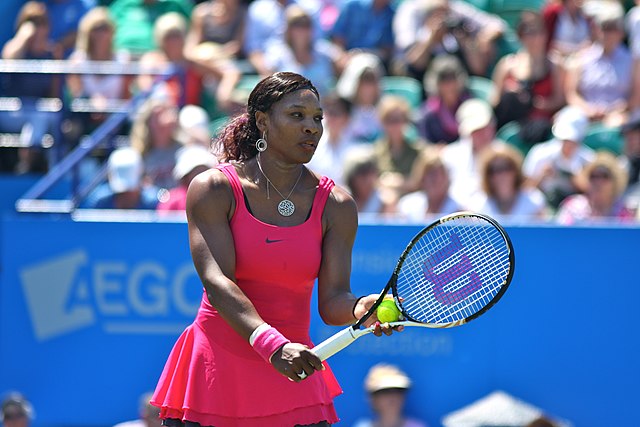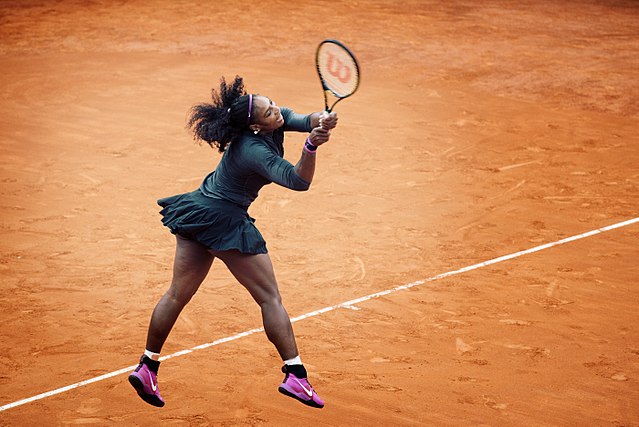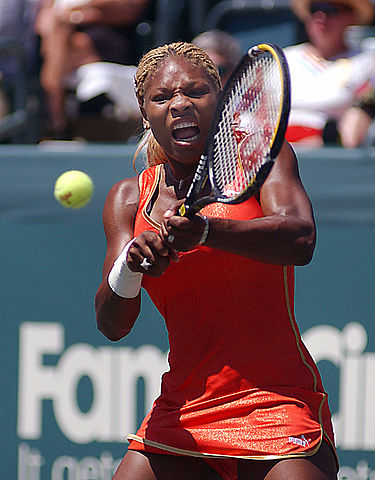
Credit: James Boyes
I’m counting down the 128 best players of the last century. If this is your favorite player, Congrats! (or: I’m sorry.)
* * *
Serena Williams [USA]Born: 26 September 1981
Career: 1998-2022
Plays: Right-handed (two-handed backhand)
Peak rank: 1 (2002)
Peak Elo rating: 2,507 (1st place, 2003)
Major singles titles: 23
Total singles titles: 73
* * *
I wasn’t paying much attention to tennis in 2002 and 2003, so I’ve learned about the first Serena Slam from a distance. Only as I was researching this essay did I discover what might be the greatest post-match interview answer ever given.
Serena Williams went to Melbourne in 2003 holding three of the four grand slam titles. She missed the 2002 Australian due to injury, so a traditional, calendar-year Grand Slam was never in play. Still, if she won the tournament in 2003, she’d possess all four at the same time. Traditionalists might asterisk it, but the American’s version–she dubbed it the Serena Slam–was essentially the same as the four-in-one-year feats of Margaret Court and Steffi Graf.
Accordingly, the pressure was high. She almost didn’t make it. Blisters on her right foot didn’t help. In the semi-finals, Kim Clijsters took a 5-1 lead in the third set.
“I knew that if I held, broke, held, and then broke again, it would be 5-all,” Serena said after the match.
If there’s been a more outrageous line in a tennis press conference in the last 20 years, I’d love to hear it.
There’s self-belief, and there’s whatever Serena Williams has.
I’m sure I don’t need to tell you, she did hold for 2-5. She broke for 3-5, saving two match points in the process. She held for 4-5, then broke again to tie the third set. By the end, Clijsters was little more than a spectator. Williams broke her one last time, at love, to finish the job, 4-6, 3-6, 7-5.
Then, for the fourth straight major, Serena defeated her sister, Venus, in the final. Their encounters were psychologically demanding and rarely brought out the best of either one. But this was one of the better matches between the two. Serena took down Venus in three sets with the same tenacity she displayed against Clijsters. The Serena Slam was hers.
At least Venus didn’t go home empty-handed. The sisters won the women’s doubles title, dropping only one set in the tournament. It was already their sixth slam championship as a team. Paola Suárez, one of the losing finalists, said, “Next year I hope Venus and Serena don’t play, so we can win the tournament.”
Williams didn’t linger. The day after she secured her fourth consecutive slam crown, she hopped a plane back to the States. She made it to her seat at the Super Bowl in time for kickoff.
* * *
Serena defended her title at Wimbledon that summer, winning another three-setter with Venus. “There’s still a lot of drama to come,” she said after the match.
Drama, yes. Major titles, too.
Yet for all the twists in the intervening decades, nearly everything we think of as distinctive about Serena Williams was present in January 2003. She won matches with a big serve and deadly groundstrokes. She outfought everybody, including her own sister. She was preternaturally self-assured. All this while saving more than a few brain cycles for off-court pursuits.
Hard to believe, then, that her game had fallen into place in little more than twelve months. Williams won her first major at the 1999 US Open, outracing her sister to the milestone by beating the top two seeds, Lindsay Davenport and Martina Hingis, in succession. She was only 17 years old.
The confidence was already there. “I fear no one,” Serena said after defeating Davenport. “I only fear God.”
But her results stagnated. She didn’t reach another major final for two years. She picked up a handful of significant victories–a title at Manhattan Beach in 2000, victories at Indian Wells and Toronto in 2001–but with a flurry of early exits and a limited playing schedule, her ranking fell to 10th in the world in late 2001.
She was “a nobody,” in her own assessment. At the same time, her fate was on her own racket. She took the credit for her victories; when she lost, she knew she could’ve played better. She dropped one match to Amélie Mauresmo in 2003. “There was nothing in particular she did,” Serena said. “When I lose a match, it’s usually because of how I played.”
By then, she wasn’t losing very often. Only five women beat her in 2002, one of them by retirement. She won eight titles and took over the number one ranking after Wimbledon.
Davenport thought that Williams’s serve was the best in the history of the game. “When she’s on, it’s scary,” said doubles specialist Lisa Raymond. “No player hits the ball like she does.”
* * *
It all started with that serve. Check that–it all began with the toss.
Serena’s toss was a moment of calm before the deluge, a precise, effortless motion that opponents found impossible to read. The only way to have a chance against a 120 mile-per-hour delivery is to correctly infer where it’s headed. Williams didn’t even give you that.
For a century, sportswriters have said of innovative women tennis stars that they “play like a man.” Helen Wills rallied from the baseline as well as men did; Alice Marble attacked the net like a man, Maria Bueno serve-and-volleyed like a man, and so on. Serena ended that line of thinking. With her serve, she effectively erased the last difference between the men’s and women’s games.
By the late 1990s, the WTA tour was crawling with muscular, big hitters. But many of them, like Jennifer Capriati, still treated their serve as a means to an end. Williams showed her peers that the first strike could be–should be, must be–a weapon in its own right.
In 2015, Serena won her 19th major with a straight-set victory over Maria Sharapova. She hit 18 aces–one out of every four service points. In the men’s final, Novak Djokovic and Andy Murray played twice as long, yet combined for only 19.
In each of her last five farewell-tour matches this summer, in Toronto, Cincinnati, and New York, Williams ended more than one-tenth of her service points with an ace. A 10% rate is standard for her–she averaged 15% in 2015–but even as the circuit has evolved to follow her example, it remains well above tour average. Elena Rybakina, the Wimbledon champion who led the category this season, fell just short of the 10% mark.
Most devastating of all, Serena was always able to deploy her most powerful weapon when it mattered. Facing break point, the typical WTA regular plays it a bit safer, hitting aces only 3% of the time. The American changed nothing. She ends 10% of those critical points with an untouchable serve. Opponents could be forgiven if it felt like more.
* * *
We could say as much about nearly every other shot in the Williams arsenal. She was swinging away at service returns twenty years ago, long before the conventional wisdom caught on to the discovery that the second strike could be nearly as devastating as the first.
Opponents raved about the forehand even before she was a grand slam champion. Sandrine Testud rated Serena’s forehand above Steffi Graf’s in 1999. Williams’s open-stance backhand, though it exposed her sometimes half-hearted footwork, could be just as blistering.
Then there was her defense. It’s easy to forget about Serena’s retrieving skills; she could go games at a stretch without needing them. But when Vera Zvonareva finished second at Wimbledon in 2010, she pointed that way to explain the champion’s dominance. “You take more risks,” she said, “because you know she’s such a great mover and can play great defense.”
Serena will never take her place in the counter-puncher Hall of Fame next to admirers Simona Halep and Caroline Wozniacki. She didn’t always look good when lunging for a last-ditch, rally-saving save. Williams might not appreciate the comparison, but this is the quality she most strikingly shared with Sharapova. If footspeed or flexibility let her down, she’d keep the point alive by sheer force of will.

Credit: Roberto Faccenda
“There are things you can’t explain,” said Serena’s coach Patrick Mouratoglou. “It’s her character; she refuses to lose and finds solutions that are incredible.”
Or as the player herself said in 2010: “If I lose, I’m going out hard.”
This is where it gets hard to capture the 23-time major winner on paper. Stock phrases like “never-say-die” and “heart-on-her-sleeve” don’t even start to cover it. No one has ever so visibly, viscerally cared. At its best, Serena’s passion gave us exploits like her in-the-bag-all-along comeback against Clijsters in 2003. At the other extreme, we saw her go toe to toe with umpires as she tried to impose her will with something other than bludgeoning groundstrokes.
The two sides of full-bore Serena couldn’t be separated. Probably no one in the history of the sport dug deeper. Some of what came out was regrettable. But a player with more conventional limits might have called it quits after six majors, or thirteen, or even twenty-three.
“I definitely didn’t see myself playing tennis at my age,” she said in 2014, eight years and 240 matches ago.
Tennis was never her only passion, but the game gave her an outlet for something she couldn’t release in any other way.
* * *
In late 1997, Serena’s career nearly ended before it began. She fell off her skateboard onto the sidewalk, jamming her left wrist. For weeks, the wrist ached every time she struck a two-handed backhand.
She made the best of it. When it hurts to hit a backhand, what better compromise than to run around it and build up an even more potent forehand? While she would’ve developed the tactic soon enough, it helped make the difference just 16 months later, when she upset Steffi Graf at Indian Wells.
That isn’t to say that the teenage Serena was a genius of injury management. After her spill, she didn’t even take the day off. She went out for a regular practice. On clay. In the rain.
Venus remembered her younger sister, as always, refusing to quit. “Just let me hit one more ball,” said the girl who winced with every backhand.
For twenty-five years, good things tended to happen when Serena decided to hit just one more ball. When they didn’t, well, she had the selective memory of a champion.
“When I lose, I don’t feel as good about myself,” she said after she defeated Angelique Kerber for her seventh Wimbledon crown. “But then I have to remind myself: You are Serena Williams.”
* * *
Previous: No. 7, Bill Tilden
Next: No. 5, Roger Federer
Subscribe to the blog to receive each new post by email:
